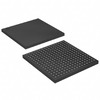Manufacturer Part Number
XC2S15-5VQG100C
Manufacturer
Xilinx
Introduction
Spartan-II series FPGA designed for high-performance logic integration and complex digital processing.
Product Features and Performance
Embedded FPGA optimized for low-power applications
Offers 96 logic blocks/CLBs and 432 logic elements/cells
Provides 16K bits of RAM for data storage
Features 60 configurable I/O pins for versatile connectivity
15K gates for complex digital circuit integration
Supports supply voltage from 2.375V to 2.625V for flexible power management
Surface Mount technology for secure and compact PCB design
Product Advantages
Reliable performance in a wide range of industrial applications
High integration capability reduces overall system cost
Low operational power suits battery-powered or power-sensitive designs
Available in a compact 100-TQFP package for space-constrained applications
Key Technical Parameters
Number of LABs/CLBs: 96
Number of Logic Elements/Cells: 432
Total RAM Bits: 16384
Number of I/O: 60
Number of Gates: 15000
Voltage Supply: 2.375V ~ 2.625V
Mounting Type: Surface Mount
Operating Temperature: 0°C ~ 85°C (TJ)
Quality and Safety Features
Rugged design suitable for wide operating temperature range
Compliance with industry standards for safety and quality
Compatibility
Compatible with standard surface mount technology equipment and PCB design practices
Software and toolchain support for design implementation and troubleshooting
Application Areas
Telecommunications
Consumer Electronics
Automotive systems
Industrial control systems
Data processing
Product Lifecycle
Currently labeled Last Time Buy indicating end-of-life status
Replacement models or upgrades may be available from Xilinx
Reasons to Choose This Product
Proven Spartan-II architecture provides a balance of cost, performance, and power consumption
High logic density suitable for complex circuit designs
Easy integration with a broad range of digital systems
Backed by Xilinx's reputation for FPGA leadership and support
Last chance to purchase for systems requiring long-term component availability




 XC2S150-5FG456AMD Xilinx
XC2S150-5FG456AMD Xilinx XC2S150-5FG256IAMDIC FPGA 176 I/O 256FBGA
XC2S150-5FG256IAMDIC FPGA 176 I/O 256FBGA